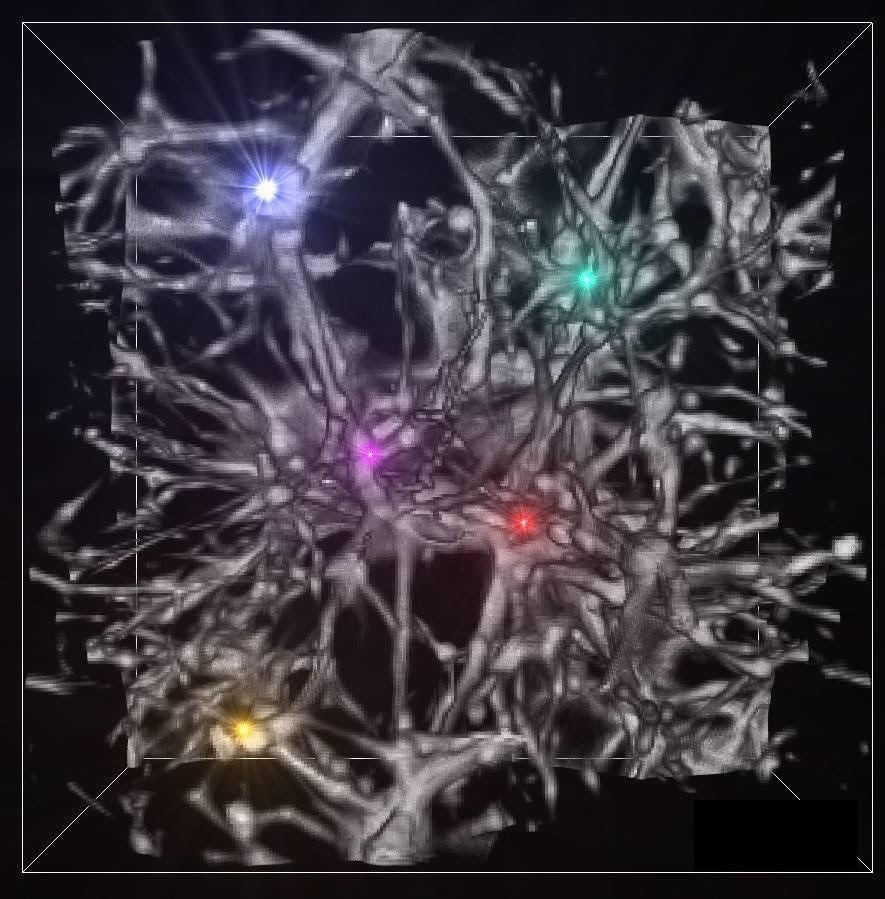Reviewed by Lexie CornerApr 2 2024
Mr. Ching-Yao Tang and Dr. Ke-Jung Chen from the Institute of Astronomy and Astrophysics, Academia Sinica (ASIAA), have achieved significant strides in deciphering the birth mass of the earliest stars.
 The image depicts the cosmological structure during the period of the first star formation, about 200 million years after the Big Bang. The gray structures illustrate the distribution of dark matter when the first stars form within some dark matter halos. The colorful spots represent stars with various masses, providing a visual representation of the complex processes shaping the early universe. Image Credit: ASIAA/ Ke-Jung Chen
The image depicts the cosmological structure during the period of the first star formation, about 200 million years after the Big Bang. The gray structures illustrate the distribution of dark matter when the first stars form within some dark matter halos. The colorful spots represent stars with various masses, providing a visual representation of the complex processes shaping the early universe. Image Credit: ASIAA/ Ke-Jung Chen
Utilizing Berkeley National Lab's potent supercomputer, they have crafted the world's first high-resolution 3D hydrodynamics simulations of turbulent star-forming clouds for these pioneering stars. This revelation is detailed in the journal Monthly Notices of the Royal Astronomical Society.
After the Big Bang, the only elements that remained in the universe were hydrogen and helium; essential elements for life, like carbon and oxygen, had yet to form. The first stars, Population III (Pop III) stars, started forming about 200 million years later.
At their cores, these stars burned nuclear material to start producing heavier elements. Some of these stars experienced supernovae as their life cycles came to an end. These were tremendous explosions that scattered freshly created elements throughout the early universe, laying the groundwork for life.
Different chemical abundance patterns result from the various types of supernovae that can occur depending on the mass of the first star at the time of its demise. Determining the average mass of the initial stars has been made possible by observations of extremely metal-poor (EMP) stars, which are formed after the initial stars and their supernovae.
According to observations, the first stars may have had masses between 12 and 60 solar masses based on the elemental abundance of EMP stars. On the other hand, earlier cosmological simulations suggested that the first stars had a broadly distributed, top-heavy mass function that ranged from 50 to 1000 solar masses. Astrophysicists have been baffled by this significant mass difference between simulations and observations for over ten years.
Ching-Yao Tang and Ke-Jung Chen have made significant progress in decoding the birth mass of the first stars. Utilizing the powerful supercomputer at Berkeley National Lab, they have crafted the world's first high-resolution 3D hydrodynamics simulations of turbulent star-forming clouds for these pioneering stars.
Their results indicate that supersonic turbulence effectively fragments the star-forming clouds into several clumps, each with dense cores ranging from 22 to 175 solar masses, destined to form the first stars of masses of approximately 8 to 58 solar masses that agree well with observations.
They can also replicate similar results from earlier simulations if the turbulence in the simulations is weak or unresolved. This finding first emphasizes the role that turbulence played in the initial stages of star formation and provides a viable way to lower the first stars’ theoretical mass scale. By effectively resolving the mass discrepancy between simulations and observations, it offers a solid theoretical framework for the first star formation.
Journal Reference:
Tang, C.-Y. & Chen, K.-J. (2024) Clumpy structures within the turbulent primordial cloud. Monthly Notices of the Royal Astronomical Society. doi.org/10.1093/mnras/stae764